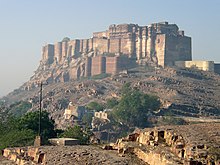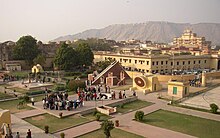
Back راجبوت Arabic راجبوت ARZ Раджпуты BE রাজপুত Bengali/Bangla Rajputs Catalan Rádžpúti Czech Rajputen German Rajput English Raĝputoj EO Rajput Spanish


Il Rajput (dal sanscrito raja-putra "Figli di re") è uno dei maggiori gruppi della casta guerriera induista kshatriya. Le loro origini sono legate al Rajputana, antico nome del Rajasthan, regione nord-occidentale dell'India, e si dicono appartenenti alla grande stirpe guerriera kshatriya. Famosi infatti per l'abilità e la cavalleria militare[1], furono impiegati dall'esercito del governo coloniale inglese ed è facile trovarne dei membri anche al giorno d'oggi nelle Forze armate indiane.
Durante l'epoca medievale e tardo feudale/coloniale, diverse parti del subcontinente indiano vennero governate da stati principeschi di varie dinastie di Rajput. I Rajput divennero influenti politicamente dopo la disgregazione degli antichi imperi indiani a partire dal VII secolo in una regione nota come Rajasthan, Delhi, Haryana, Pianura indo-gangetica e Bundelkhand.[2][3][4][5][6][7][8][9][10][11]
Ad ogni modo il termine "Rajput" è stato utilizzato come termine anacronistico per indicare le dinastie indù precedenti al XVI secolo in quanto non sono disponibili genealogie antecedenti a questo periodo.[12][13][14][15][16]
- ^ (EN) James Tod, Annals and Antiquities of Rajasthan, or the Central and Western Rajput States of India, 2ª ed., Londra, Oxford University Press, 1920 [1873], SBN MIL0729612.
- ^ (EN) Hermann kulke, A History of India, Psychology Press, 2004, p. 116, ISBN 978-0-415-32920-0.«"When Harsha shifted the centre of north India history to Kannauj in mids of Ganga-Jamuna doab the tribes living in the west of this new centre also became more important for further courses of Indian history. They were first and foremost the Rajputs who now emerged into limelight of Indian history"»
- ^ (EN) Sailendra Nath Sen, Ancient Indian History and Civilization, New Age International, 1999, p. 307, ISBN 978-81-224-1198-0.«"The anarchy and confusion which followed the death of Harsha is a transitional period of history. This period was marked by the rise of the Rajput clans who began to play a conspicuous part in the history of northern and western India from eighth century A.D. onwards"»
- ^ (EN) Alain Danielou, A Brief History of India, Simon and Schuster, 2003, p. 87, ISBN 978-1-59477-794-3.«"The Rajputs The rise of Rajputs in the history of northern and central India is considerable, as they dominated the scene between the death of Harsha and the establishment of the Muslim Empire"»
- ^ (EN) Brajadulal Chattopadhyaya, Studying Early India: Archaeology, Texts and Historical Issues, Anthem, 2006, p. 116, ISBN 978-1-84331-132-4.«"The period between seventh and twelfth century witnessed gradual rise of a number of new royal-lineages in Rajasthan, Gujarat, Madhya Pradesh and Uttar Pradesh which came to constitute a social-political category known as Rajputs"»
- ^ (EN) Satish Chandra, Historiography, Religion, and State in Medieval India, Har-Anand Publications, 1996, p. 115, ISBN 978-81-241-0035-6.«"In north India, dominant features of the period between 7th and 12th centuries have been identified as the growing weakness of state; the growth of power of local landed elittes and their decentralising authority by acquiring greater administrative, economic and political roles, the decline of towns, the setback to trades, This period between 7th to 12th century is also noted for rise of Rajputs»
- ^ (EN) Sara R. Farris, Max Weber's Theory of Personality: Individuation, Politics and Orientalism in the Sociology of Religion, BRILL, 5 settembre 2013, p. 145, ISBN 978-90-04-25409-1.«"In about the eight century the Rajput thus began to perform the functions that had formerly belonged to the Kshatriya, assuming their social and economic position and substituting them as the new warrior class»
- ^ (EN) Eugenia Vanina, Medieval Indian Mindscapes: Space, Time, Society, Man, Primus Books, 2012, p. 140, ISBN 978-93-80607-19-1.«"By the period of seventh–eights centuries AD when the first references to the Rajput clans and their chieftains were made"»
- ^ (EN) Peter Robb, A History of India, Macmillan International Higher Education, 21 giugno 2011, pp. 103, ISBN 978-0-230-34549-2.«From around 1000 ce notable among these regional powers were various Rajput dynasties in the west and north»
- ^ Burton Stein, A History of India, a cura di Arnold, 2nd, Oxford, Wiley-Blackwell, 2010, p. 109.«"The Rajput claim as a community were recorded in Sanskrit inscriptions that constituted as well as recorded in Rajasthan during the seventh century, when Rajputs begins to make themselves lords of various localities»
- ^ David Ludden, India and South Asia: A Short History, Oneworld Publications, 2013, pp. 88–, ISBN 978-1-78074-108-6.«By contrast in Rajasthan a single warrior group evolved called Rajput (Rajaputra-son of kings), they rarely engaged in farming, even to supervise from labour as farming was literally benath them, farming was for their peasant subjects. In ninth century separate clans of Rajputs Cahamanas (Chauhans), Paramaras (Pawars), Guhilas (Sisodias) and Caulukyas were spitting off from Gurjara Pratihara clans.»
- ^ Norbert Peabody, Hindu Kingship and Polity in Precolonial India, Cambridge University Press, 2003, pp. 38–, ISBN 978-0-521-46548-9.«As Dirk Kolff has argued, it was privileged, if not initially inspired, only in the sixteenth and seventeenth centuries by Mughal perceptions of Rajputs which, in a pre-form of orientalism, took patrilineal descent as the basis for Rajput social Organization and consequently as the basis for their political inclusion into the empire. Prior to the Mughals, the term 'Rajput' was equally an open-ended, generic name applied to any ‘"horse soldier", "trooper", or "headman of a village"’ regardless of parentage, who achieved his status through his personal ability to establish a wide network of supporters through his bhaibandh (lit. 'ie or bond of brothers'; that is, close collateral relations by male blood) or by means of naukari (military service to a more powerful overlord) and sagai (alliance through marriage). Thus the language of kinship remained nonetheless strong in this alternative construction of Rajput identity but collateral and affinal bonds were stressed rather than those of descent. During the sixteenth and seventeenth cen-»
- ^ Peter Jackson, The Delhi Sultanate: A Political and Military History, Cambridge University Press, 2003, pp. 9–, ISBN 978-0-521-54329-3.«Confronting the Ghurid ruler now were a number of major Hindu powers, for which the designation 'Rajput' (not encountered in the Muslim sources before the sixteenth century) is a well-established anachronism. Chief among them was the Chahamana (Chawhan) kingdom of Shakambhari (Sambhar), which dominated present-day Rajasthan from its capital at Ajmer»
- ^ Susan Bayly, Caste, Society and Politics in India from the Eighteenth Century to the Modern Age, Cambridge University Press, 2001, pp. 39–, ISBN 978-0-521-79842-6.«Yet the varna archetype of the Kshatriya-like man of prowess did become a key reference point for rulers and their subjects under the Mughals and their immediate successors. The chiefs and warriors whom the Mughals came to honour as Rajput lords in the sixteenth and seventeenth centuries may not even have been descendants of Rajasthan's earlier pre-Mughal elites.»
- ^ Aditya Behl, Love's Subtle Magic: An Indian Islamic Literary Tradition, 1379-1545, a cura di Wendy Doniger, Oxford University Press, 2012, pp. 364–, ISBN 978-0-19-514670-7.«The term Rajput is a retrospective invention, as most of the martial literature of resistance to Turkish conquest dates only from the mid-fifteenth century onward. As Dirk Kolff has noted in his Naukar, Rajput and Sepoy: The Ethnohistory of the Military Labour Market in Hindustan, 1450-1850 (Cambridge: Cambridge University Press, 1990), the invention of "Rajput" identity can be dated to the sixteenth-century narratives of nostalgia for lost honor and territory.»
- ^ Richard M. Eaton, India in the Persianate Age: 1000-1765, Penguin UK, 25 luglio 2019, pp. 51–, ISBN 978-0-14-196655-7, OCLC 1088599361.«Often projected back to the twelfth century or even earlier, the term 'Rajput' has been called a 'well-established anachronism»